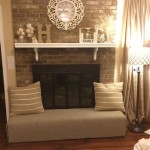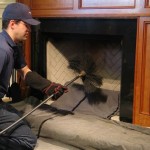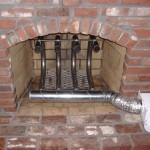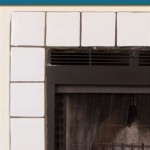Corner Wood Burning Fireplace Ideas: Maximizing Space and Ambiance
A corner wood-burning fireplace presents a unique opportunity to enhance both the visual appeal and functionality of a living space. Unlike traditional fireplaces centered on a wall, a corner fireplace leverages often-underutilized areas, creating a focal point while conserving space. This design choice offers a blend of rustic charm and modern efficiency, appealing to homeowners seeking both warmth and aesthetic value. Successfully integrating a corner wood-burning fireplace requires careful planning, considering factors such as spatial constraints, ventilation needs, and desired architectural style.
The appeal of a wood-burning fireplace stems from its ability to provide authentic heat and a captivating visual display. The crackling sounds and flickering flames create a cozy atmosphere often associated with relaxation and comfort. When positioned in a corner, this ambiance is radiated throughout the room, effectively warming the surrounding areas. Furthermore, a corner fireplace can serve as a natural anchor for furniture arrangements, defining the space and creating a cohesive living environment.
This article explores various design ideas for corner wood-burning fireplaces, focusing on different styles, materials, and installation considerations. By examining these diverse approaches, homeowners can gain valuable insights into creating a fireplace that seamlessly complements their existing decor and meets their individual needs. The selection of the right design requires careful consideration of the architectural style of the home, the available space, and the desired aesthetic. The following sections delve into specific considerations regarding design, practical requirements, and safety measures.
Optimizing Space and Design with Corner Fireplaces
One of the primary advantages of a corner wood-burning fireplace is its ability to optimize space utilization. Traditional fireplaces often require a large, dedicated wall, which can limit furniture placement and room flow. Conversely, a corner fireplace fits neatly into an existing corner, freeing up valuable wall space for other purposes such as shelving, artwork, or entertainment centers. This is particularly beneficial in smaller homes or apartments where maximizing space is crucial.
The design possibilities for corner fireplaces are diverse, ranging from minimalist modern designs to rustic, traditional styles. A contemporary corner fireplace might feature clean lines, smooth surfaces, and a sleek metal surround. This design emphasizes simplicity and functionality, blending seamlessly with modern decor. Alternatively, a rustic corner fireplace could incorporate natural stone, exposed brick, and a robust wooden mantel, evoking a sense of warmth and history. The choice of materials plays a significant role in defining the overall aesthetic. Stone offers a timeless appeal and can be used to create a variety of textures and patterns. Brick provides a classic, industrial look, while metal surrounds offer a modern, sophisticated touch.
Another important aspect to consider is the shape and size of the fireplace itself. Corner fireplaces can be designed with a triangular or curved front, depending on the desired aesthetic and spatial constraints. A triangular fireplace fits snugly into the corner, maximizing space efficiency. A curved fireplace, on the other hand, adds a touch of elegance and softens the angles of the room. The height of the fireplace should also be proportionate to the size of the room. A tall, imposing fireplace can overwhelm a small space, while a low, understated fireplace might get lost in a larger room. Moreover, customizing the corner where the fireplace will be installed with design elements such as custom tiling or wall-mounted shelves can give prominence to the fireplace.
Furthermore, the surrounding area can be enhanced with strategic lighting and decor. Recessed lighting can highlight the texture of the fireplace surround, while strategically placed candles or lanterns can add to the ambiance. A comfortable seating arrangement facing the fireplace encourages relaxation and social interaction. A rug placed in front of the fireplace defines the space and adds warmth to the room. The selection of furniture and accessories should complement the overall style of the fireplace and create a cohesive and inviting atmosphere. The use of warm, earthy tones can enhance the cozy feel, while pops of color can add visual interest. The goal is to create a space that is both functional and aesthetically pleasing, reflecting the homeowner's personal style.
Practical Considerations for Wood-Burning Fireplaces
Beyond aesthetics, practical considerations are paramount when installing a corner wood-burning fireplace. Proper ventilation is essential to ensure safe and efficient operation. A chimney or flue is required to vent smoke and gases outside the home. The chimney should be properly sized and constructed to meet local building codes. Regular cleaning and maintenance are necessary to prevent creosote buildup, which can pose a fire hazard. A professional chimney sweep should be contracted annually to inspect and clean the chimney.
The type of wood used in the fireplace also affects its performance. Seasoned hardwood, such as oak, maple, or birch, burns hotter and cleaner than softwood. Green or unseasoned wood contains a high moisture content, which can lead to excessive smoke and creosote buildup. Firewood should be stored in a dry, well-ventilated area to prevent rot and insect infestation. A wood rack placed near the fireplace provides convenient access to firewood and adds to the rustic charm of the space.
In addition to ventilation and fuel considerations, fire safety is of utmost importance. A fire screen or glass door should be installed to prevent sparks and embers from escaping the fireplace. A fire extinguisher should be readily accessible in case of emergency. Smoke detectors and carbon monoxide detectors should be installed throughout the home to provide early warning of potential hazards. It is crucial to educate all household members about fire safety procedures and to regularly practice fire drills. Proper ventilation while the fireplace is in use is paramount to avoid carbon monoxide presence.
Another practical aspect to consider is the heat output of the fireplace. The size of the fireplace should be appropriate for the size of the room. A fireplace that is too large can overheat the space, while a fireplace that is too small may not provide sufficient warmth. Factors such as insulation, window placement, and ceiling height can also affect the heating efficiency of the fireplace. It is advisable to consult with a qualified heating professional to determine the appropriate size and type of fireplace for the specific needs of the home. Modern wood-burning fireplaces often incorporate features such as air wash systems and catalytic combustors to improve efficiency and reduce emissions. These technologies help to burn wood more completely, resulting in less smoke and creosote buildup. The EPA provides certification for fireplaces meeting specific efficiency and emissions standards.
Enhancing Safety and Efficiency in Corner Fireplace Design
Safety and efficiency are not mutually exclusive; in fact, they are interconnected aspects of a well-designed corner wood-burning fireplace. Implementing safety measures not only protects the occupants of the home but also contributes to the long-term efficiency of the fireplace. Regular maintenance, such as chimney cleaning and inspection, helps prevent fires and ensures that the fireplace operates at its optimal performance. The right kind of firewood is also important – dry, seasoned hardwood burns cleaner and produces less creosote than wet or softwood. Using a fireplace insert is also something to consider. Fireplace inserts can greatly improve the heating efficiency of a fireplace, while also greatly reducing the risk of fire. Some inserts also come with added features such as blowers to help better circulate the heat.
Beyond these essential maintenance practices, homeowners can implement additional safety and efficiency measures. Installing a carbon monoxide detector near the fireplace is crucial, as carbon monoxide is a colorless, odorless gas that can be deadly. Ensuring proper ventilation is also essential, not only for exhausting smoke and gases but also for providing adequate combustion air. A lack of combustion air can result in incomplete burning, leading to increased smoke and carbon monoxide production. Furthermore, using a fireplace screen or glass door can help prevent sparks and embers from escaping the fireplace, reducing the risk of fire. The type of glass used in the fireplace is also an important part of the design. Tempered glass is recommended as it can withstand high heat.
Efficiency can be further improved by considering the design of the fireplace itself. Fireplaces with airtight doors and adjustable air controls allow for greater control over the burning process, resulting in more efficient combustion. Some fireplaces also incorporate features such as heat-circulating blowers, which help to distribute heat more evenly throughout the room. These blowers can significantly improve the heating efficiency of the fireplace, reducing the need for supplemental heating. In addition, the insulation of the chimney and firebox can play a significant role in preventing heat loss. Proper insulation helps to keep the heat generated by the fireplace inside the home, rather than allowing it to escape through the chimney. Ensuring that the firebox is built with high-quality heat-resistant materials is something to also consider.
Moreover, embracing smart home technology can further enhance the safety and efficiency of a corner wood-burning fireplace. Smart thermostats connected to the central heating system can automatically adjust the temperature in the room when the fireplace is in use, preventing overheating. Smart smoke detectors can provide early warning of potential fires, even when the occupants are not at home. Smart fireplace controls can allow homeowners to remotely monitor and adjust the operation of the fireplace, ensuring optimal performance and safety. These technologies offer a proactive approach to managing the fireplace, maximizing its benefits while minimizing its risks. By integrating these design considerations, homeowners can enjoy the warmth and ambiance of a corner wood-burning fireplace safely and efficiently for years to come.

Cozy Fall Vibes

Corner Mantel Wood Burning Stoves Living Room Fireplace Decor Stove

Mantle Ideas Wood Burning Stoves Living Room Home Fireplace Farm House

Fireplace Stunning Corner Living Design Ideas Your Room For44 Idea Comfy Decor

Cozy Corner Fireplace Ideas Barron Designs

8 Clever Corner Stove Ideas Enhance Your Space

How To Make A Corner Fireplace Mantel Look Good 15 Examples

61 Amazing Wood Burning Stove Ideas Hearths Surrounds

Corner Wood Stove Surround Hearth

16 Best Diy Corner Fireplace Ideas For A Cozy Living Room In 2024
Related Posts








